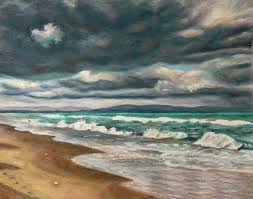|
Art Challenge:
Use pastels to create a drawing of a beach landscape that captures warmth, light and depth Hello,
Today you need to complete the following: Sketch the design for your collage inside of the large rectangle that you drew yesterday. Make sure that you include background, middleground and foreground. You may turn the paper and create a horizontal or vertical format. After you have sketched out your design you need to go through the magazines ( under the table with the pencil sharpener by my desk) and collect the colors, patterns and shapes that you need to create your collage. I will show you on Thursday how to glue them down, just focus on collecting all of the colors that you will need. On the large table there are large manila envelopes for you to store the magazine clippings and pieces that you collect. At the end of the period you will need to clean up any paper scraps and make sure all supplies are put away. Art History Challenges and other assignments must be turned in TODAY to receive credit. Please EDIT all work prior to uploading it to the folder. Please check your school email for the shared folder link. There are folders for the following assignments: Art History Challenge #7 David Hockney Art History Challenge #8 Louise Nevelson Art Gallery Critique of Laura Philips Photography David Hockney Photo Collage Photograph of Color Wheel The Cambridge Street Gallery is currently exhibiting the work of artist and middle school art teacher, Laura Phillips. Objectives: Create a series of color collages that create optical illusions and demonstrate your understanding of color theory
Art Challenge: Create four color collage that illustrate your understanding of color harmonies 1. Color Harmonies - or color scheme is the use of two or more colors in a single composition. a. Monochromatic - all the same hues or colors, though the value and intensity can be different b. Complementary Harmonies - hues of directly opposite values on the color wheel are used, i.e.: Red and Green. c. Analogous Harmonies - color adjacent to one another on the color wheel are used, red and red-orange. d. Triadic Harmonies - the use of three colors equidistant on the color wheel. Steps: 1. Read and understand the links on the post " Color Theory Resources" 2. Read and examine the work of artist Josef Albers 3. Cut four squares of colors 4. Cut out other color squares of various sizes and colors 5. Create four collages that show the following color harmonies: Monochromatic, Complementary, Analogous and Triadic 6. Glue collages together 7. Mat all collages Evaluation: Understanding of color theory Ability to create a collage that illustrates the color harmony Craftsmanship Effort "In visual perception a color is almost never seen as it really is - as it physically is. This fact makes color the most relative medium in art." Josef Albers was a painter, poet, sculptor, art theorist, and an educator. Through his teachings he introduced a generation of American artists to the European modernist concepts of the Bauhaus. His experimentation with color interaction and geometric shapes transformed the modern art scene, offering an alternative to Abstract Expressionism and inspiring movements such as Geometric Abstraction, Color field painting, and Op Art. -
See more at: http://www.theartstory.org/artist-albers-josef.htm#sthash.5CSDY5S7.dpuf |
Studio ArtThis is full year foundation course that will aid in your understanding and creating a wide variety of 2-D and 3-D artwork.
Course ExpectationsWeekly
|





